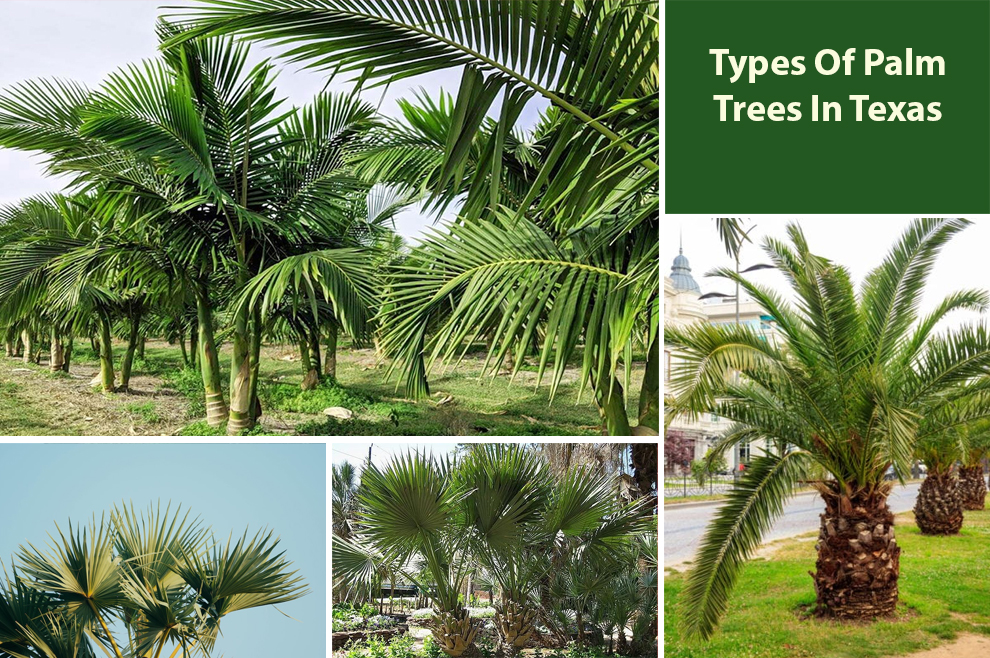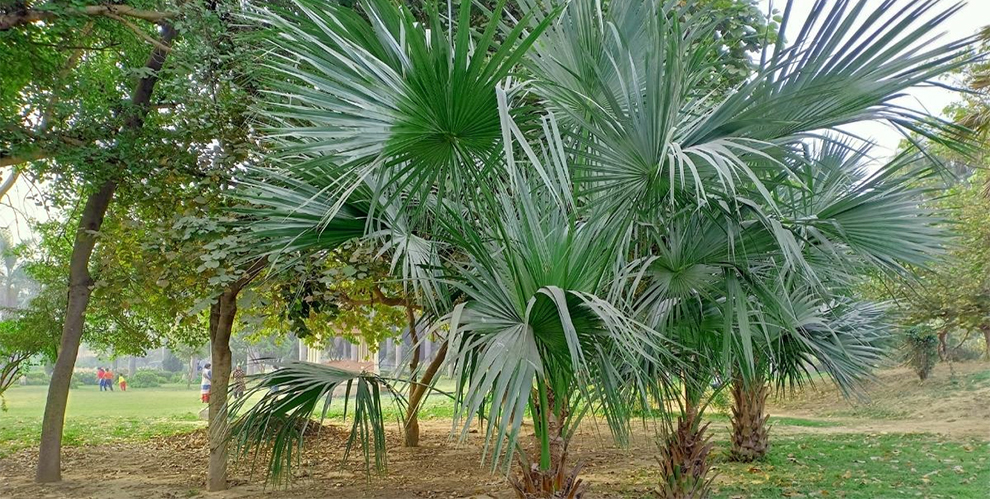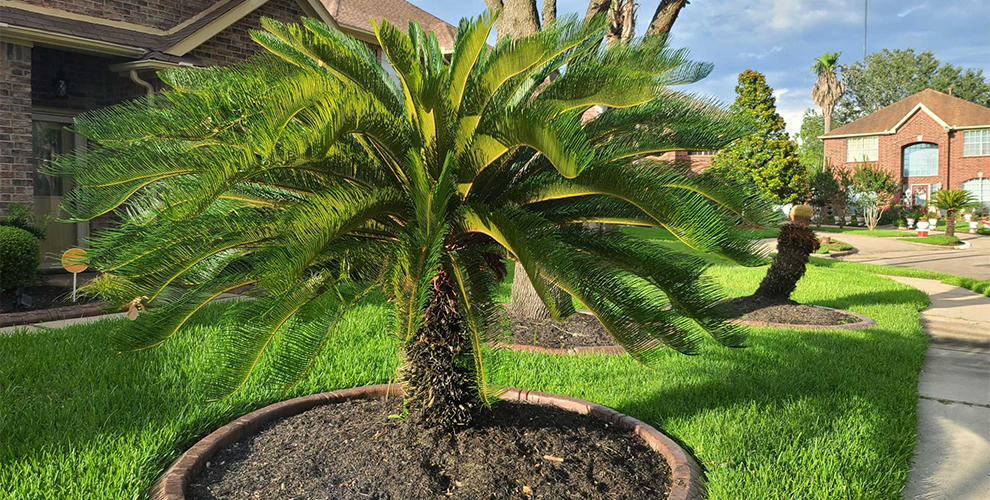Types Of Palm Trees In Texas That Thrive
Texas is a Tropical Oasis in the Lone Star State. It houses palm trees like Mexican Fan Palm, Sabal Palm, Windmill Palm, Texas sago Palm and many more.

When one thinks of Texas, vast landscapes of plains, rugged canyons, and bustling cities come to mind.
However, there is another side to the Lone Star State that brings a touch of the tropics – the diverse array of Texas palm trees that flourish across its warm and welcoming regions. Generally, over 20 different species of palm trees can be found in Texas.
Some of the most common palm tree varieties in the state include Mexican Fan Palm, Canary Island Date Palm, Windmill Palm, Sabal Palm, Mediterranean Fan Palm, Pindo Palm, Sylvester Palm, and Texas Sago Palm, among others.
Texas, with its varied climates and ecosystems, provides an ideal environment for these palm tree species to thrive.
From towering fan palms to graceful date palms, let’s explore the mesmerizing world of palm trees in Texas.
Different Types of Palm Trees In Texas
Commonly found Palm trees in Texas are:
- Sabal Palm
- Mexican fan palm
- Canary Island date palm
- Mediterranean Fan Palm
- Windmill Palm
- Texas Palm
- Pindo Palm
- Sylvester Palm
- Texas Sago Palm
- Queen Palm
- Pygmy Date Palm
- Bismarck Palm
Let us look at some of these palm trees popular in Texas in greater detail.
1. Sabal Palm (Sabal mexicana)
The Sabal palm, also known as the Texas Sabal or the Texas Palmetto, is the state tree of Texas. This hardy palm species is native to the southeastern United States and Mexico and can withstand a range of growing conditions.
Recognizable by its fan-shaped leaves and stout trunk, the Sabal palm is a symbol of resilience in the face of adversity.
It is well-adapted to Texas’s diverse climates, from the coastal regions to the inland areas, making it a prominent sight throughout the state.
2. Mexican Fan Palm (Washingtonia robusta)
Native to northern Mexico, the Mexican Fan Palm has become a familiar sight in many Texas landscapes.
Characterized by its tall and slender trunk, reaching heights of up to 100 feet, this palm species adds an elegant touch to city streets, parks, and residential neighborhoods. Check out this care guide for Mexican fan palms.
Its fan-shaped leaves gracefully sway in the breeze, creating a picturesque tropical ambiance. Mexican Fan Palms are widely cultivated due to their adaptability to Texas’ hot and arid climate.
3. Canary Island Date Palm (Phoenix canariensis)
This majestic palm tree originates from the Canary Islands but has found a welcoming home in Texas.
The Canary Island Date Palm is renowned for its towering height, reaching up to 60 feet, and its striking, arching fronds with spines along the petioles.
It is a popular choice for landscaping in Texas, especially in urban and resort areas, adding a touch of grandeur and sophistication to the environment.
4. Mediterranean Fan Palm (Chamaerops humilis)
As one of the hardiest palms, the Mediterranean Fan Palm thrives in a range of climates, including the warm regions of Texas.
It is among the low-growing, clumping Texas palm trees with fan-shaped leaves and spines along the petioles.
Often used for hedges or as accent plants, this palm species brings a sense of exotic beauty to gardens and landscapes throughout the state.
5. Windmill Palm (Trachycarpus fortunei)
Hailing from East Asia, the Windmill Palm is a cold-hardy species that can endure Texas’ occasional freezing temperatures.
It boasts fan-shaped leaves with a distinct “windmill-like” appearance, making it a unique and attractive addition to gardens and landscapes in both warmer and cooler regions of Texas.
6. Texas Palm (Sabal texana)

This native palm species is specifically found in the southern regions of Texas. With its distinctive blue-green fronds and thick, woody trunk, the Texas Palm is well-adapted to the state’s subtropical and coastal climates.
It is commonly spotted in South Texas’ riparian areas and serves as a vital habitat for various wildlife.
7. Pindo Palm (Butia capitata)
Also known as the Jelly Palm, this South American native is well-suited to Texas’ hot and arid climate.
The Pindo Palm features arching, silvery-blue to green pinnate leaves and produces sweet, edible orange-yellow fruits. It is often planted in gardens and landscapes, adding a touch of tropical beauty to the Texan scenery.
8. Sylvester Palm (Phoenix sylvestris)
Native to South Asia, the Sylvester Palm has found a welcoming home in the southern regions of Texas. It is a medium to large-sized palm with a stout trunk and graceful, feather-like fronds.
This palm species thrives in the heat and can tolerate periods of drought, making it a popular choice for landscaping in Texas’ warmer climates.
9. Texas Sago Palm (Cycas revoluta)

Although not a true palm tree, the Sago Palm is commonly referred to as one due to its palm-like appearance. This ancient and resilient plant is native to southern Japan but has been cultivated in Texas for its ornamental value.
Its distinctive, feathery fronds and stout trunk make it a charming addition to gardens and landscapes in the state.
10. Queen Palm (Syagrus romanzoffiana)
Native to South America, the Queen Palm has adapted well to Texas’ warm and subtropical regions. This graceful palm boasts a slender trunk and arching, pinnate leaves.
It is often seen lining streets or adding a tropical flair to residential gardens, providing shade and aesthetic appeal.
Related: How to grow queen palm | Queen palm growth rate
11. Pygmy Date Palm (Phoenix roebelenii)
As a compact and slow-growing palm, the Pygmy Date Palm is a popular choice for small gardens, patios, and even indoor spaces in Texas. Read more about pygmy palm’s growth rate here.
Its finely pinnate leaves and slender trunk give it a charming and delicate appearance, making it a favorite among homeowners seeking a touch of tropical allure.
12. Bismarck Palm (Bismarckia nobilis)
Native to Madagascar, the Bismarck Palm thrives in Texas’ warmer regions, adding a touch of grandeur to the landscape.
This large palm features striking silvery-blue, circular fan-shaped leaves and a robust trunk, making it an eye-catching focal point in gardens and resorts.
Related: Palm Trees in Miami, San Diego Palm Trees, Palm Trees in Arizona ,South Carolina Palm Trees,California Palm Trees,Alabama Palm Trees,Florida Palm Trees,Palm Trees in Australia ,Brisbane.
In conclusion, Texas is a tropical oasis in the heart of the United States, boasting an impressive array of Texas palm trees. From towering fan palms to cold-hardy windmill palms, each species contributes its unique charm to the diverse landscapes of the Lone Star State.
Whether lining city streets or gracing suburban gardens, these palm trees add a touch of the exotic, reminding Texans and visitors alike of the breathtaking beauty found within their own borders.
